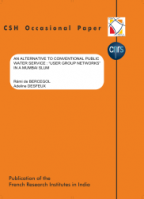Measuring Urbanization around a Regional Capital : The Case of Bhopal District
The starting point of this study is the observation that many villages in India seem to
possess urban characteristics. As compared to definitions of urbanization adopted by
other countries, the Indian definition of urban area is actually unique in the world. One of
the consequences of a restrictive definition is that it potentially excludes numerous
localities. This paper consequently explores a multi-dimensional approach to answer the
question of what is an urban area.
For this purpose, a literature review of various definitions of the notion of urban,
urbanism and urbanity from different disciplines, enables to develop indicators
susceptible to enter a multi-dimensional approach. The paper follows various approaches
to operationalize such an indicator and goes beyond the census definitions. It suggests a
palette of indicators (demographic, social, economic, spatial, infrastructural and
administrative) to categorize rural and urban localities which open up an important debate
on the notion of urbanity.
This methodological tool is then applied in a set of eight villages around Bhopal, the
capital of Madhya Pradesh. In particular, the study identified two types of urban areas,
those under the influence of Bhopal (suburban type) and those with a large degree of
autonomy (growth-centre type). The results show that even in a sub-metropolitan
environment, localities are very diverse and that factors of transformation depend on
multiple factors ranging from accessibility and location to situated historical capital.
Finally, this working paper demonstrates that studying urbanization only within the
Census classified urban local units is certainly limiting and a broader approach may help
us better understand the spread of urban characteristics in India even in small settlements
and micro agglomerations.and micro agglomerations.
PDF : Télécharger
- By:
- In :USR 3330 “Savoirs et Mondes Indiens”
- Year :2013
- Pages :76








